Frequently Asked Questions (F.A.Q.)
Why do you need to brush your teeth
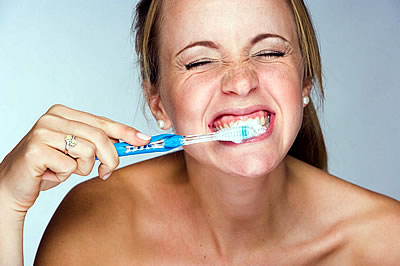 Brushing helps prevent tooth decay. Dental plaque is a soft, sticky substance that builds up on your teeth. It is mostly made up of bacteria, which feed on sugar from food and drink, producing acids as a waste product. The acids attack the teeth by dissolving the minerals in the tooth surface. If this happens too often, tooth decay results. For this reason, you shouldn´t have sugary foods and/ or drinks too often during the day.
Brushing helps prevent tooth decay. Dental plaque is a soft, sticky substance that builds up on your teeth. It is mostly made up of bacteria, which feed on sugar from food and drink, producing acids as a waste product. The acids attack the teeth by dissolving the minerals in the tooth surface. If this happens too often, tooth decay results. For this reason, you shouldn´t have sugary foods and/ or drinks too often during the day.
Minerals in saliva can mend the teeth. If fluoride is present in the mouth, it helps teeth to repair themselves. Fluoride also makes bacteria less able to produce acid. To remove plaque and help teeth to mend themselves, you need to brush twice a day with a fluoride toothpaste.
Brushing helps prevent gum disease. You also need to brush to stop plaque damaging your gums. If plaque is allowed to build up, the bacteria in it can make your gums sore and infected. Painless gum “pockets” will start to form around the teeth and bone supporting the teeth will slowly be lost. If left unchecked, gum disease will lead to the loss of teeth.
How should I brush?
- Brush your teeth thoroughly twice a day with a soft-to-medium brush and fluoride toothpaste. Replace the brush when the bristles get out of shape.
- Put the bristles at the join between teeth and gums, pointing towards the gums, and brush using short circular movements.
- Brush all round every tooth, carefully making sure you can feel the brush on your gums.
- Don´t use too much force give your teeth and gums a gentle scrub. Thorough brushing takes two or three minutes; why not time yourself?
- After brushing, you should spit out the toothpaste but do not rinse, as this lessens the effect of the fluoride.
- Small children should only use a small, pea-sized amount of fluoride toothpaste. They cannot brush properly until they are at least six or seven, so an adult should help them brush their teeth. One way is to stand behind the child and tilt their head back so all the teeth can be seen and reached.
Scaling and polishing
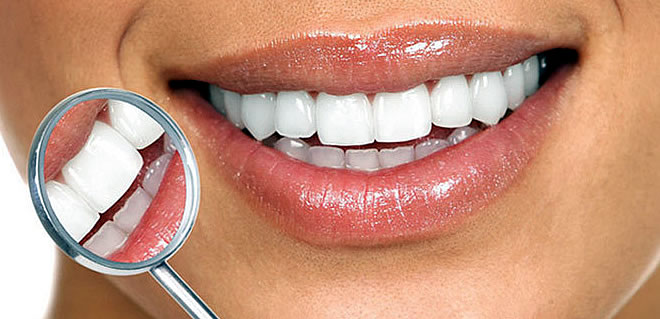 What is it?
What is it?
Plaque is a soft, sticky substance that builds up on your teeth. It is mostly made up of bacteria.
The bacteria in plaque feed on sugar from food and drink, producing acids as a waste product. The acids attack the teeth by dissolving the minerals in the tooth surface. If this happens too often, tooth decay results.
And, if plaque is allowed to build up, the bacteria in it can cause gum disease, making your gums sore and infected.
Tartar (also known as "calculus"), formed by hardened plaque, helps plaque to gather and makes it harder to remove when you brush.
You can´t remove tartar lust by brushing your teeth, but a dentist or hygienist can remove it using special instruments - this is known as scaling.
A dentist or hygienist can also polish your teeth. This removes stains from coffee, tea, cigarettes or red wine; and it makes it more difficult for plaque to stick to your teeth.
If you clean your teeth very thoroughly at home, your scale and polish treatment will take less time.
What happens?
Dentists and hygienists use two types of instrument for scaling:
- Hand scalers are metal scrapers that come in different sizes and shapes, to reach different parts of the teeth. This is why you will see the dentist or hygienist changing instruments quite often.
- Electric scalers use a tip that vibrates very fast in a stream of water. The water is removed from your mouth using a small suction device. A hand scaler is also used along with an electric scaler, to check whether the teeth are completely clean.
- For polishing, your dentist will use a rotating brush or rubber polisher with a special toothpaste. Scaling cleans above and below the gumline.
If you have gum disease, you may also need deeper scaling, around the roots of the teeth - this is called "root planing". Your dentist may give you a local anaesthetic for this.
Your dentist or dental hygienist will also tell you about the best way to clean your teeth and gums thoroughly at home.
What are the benefits?
- Regular scaling and polishing by a dentist or hygienist help keep your teeth and gums healthy by making it easier for you to keep your teeth clean at home. You should see and feel the difference.
- If your gums bleed when you brush, you may have early gum disease. Regular scaling helps to stop the disease getting worse; and it helps you to eliminate the disease by thorough cleaning at home.
- Bad breath is often caused by gum disease. Regular scaling, and cleaning your teeth thoroughly at home, can prevent this.
Visiting the Hygienist
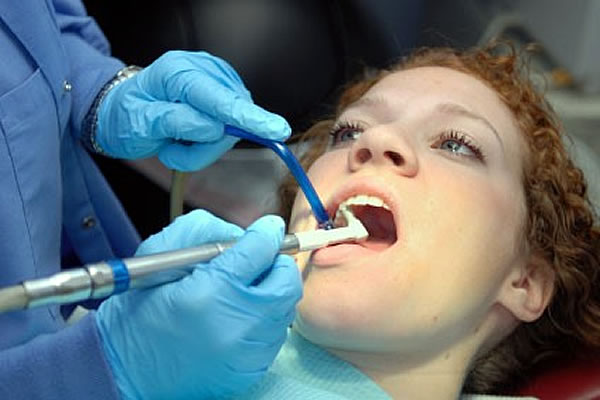 What is it?
What is it?
Plaque is a soft, sticky substance that builds up on your teeth. It is mostly made up of bacteria.
The bacteria in plaque feed on sugar from food and drink, producing acids as a waste product. The acids attack the teeth by dissolving the minerals in the tooth surface. If this happens too often, tooth decay results.
And, if plaque is allowed to build up, the bacteria in it can cause gum disease, making your gums sore and infected.
Tartar (also known as "calculus"), formed by hardened plaque, helps plaque to gather and makes it harder to remove when you brush.
You can´t remove tartar lust by brushing your teeth, but a dentist or hygienist can remove it using special instruments - this is known as scaling.
A dentist or hygienist can also polish your teeth. This removes stains from coffee, tea, cigarettes or red wine; and it makes it more difficult for plaque to stick to your teeth.
If you clean your teeth very thoroughly at home, your scale and polish treatment will take less time.
What happens?
Dentists and hygienists use two types of instrument for scaling:
- Hand scalers are metal scrapers that come in different sizes and shapes, to reach different parts of the teeth. This is why you will see the dentist or hygienist changing instruments quite often.
- Electric scalers use a tip that vibrates very fast in a stream of water. The water is removed from your mouth using a small suction device. A hand scaler is also used along with an electric scaler, to check whether the teeth are completely clean.
- For polishing, your dentist will use a rotating brush or rubber polisher with a special toothpaste. Scaling cleans above and below the gumline.
If you have gum disease, you may also need deeper scaling, around the roots of the teeth - this is called "root planing". Your dentist may give you a local anaesthetic for this.
Your dentist or dental hygienist will also tell you about the best way to clean your teeth and gums thoroughly at home.
What are the benefits?
- Regular scaling and polishing by a dentist or hygienist help keep your teeth and gums healthy by making it easier for you to keep your teeth clean at home. You should see and feel the difference.
- If your gums bleed when you brush, you may have early gum disease. Regular scaling helps to stop the disease getting worse; and it helps you to eliminate the disease by thorough cleaning at home.
- Bad breath is often caused by gum disease. Regular scaling, and cleaning your teeth thoroughly at home, can prevent this.
Gum disease
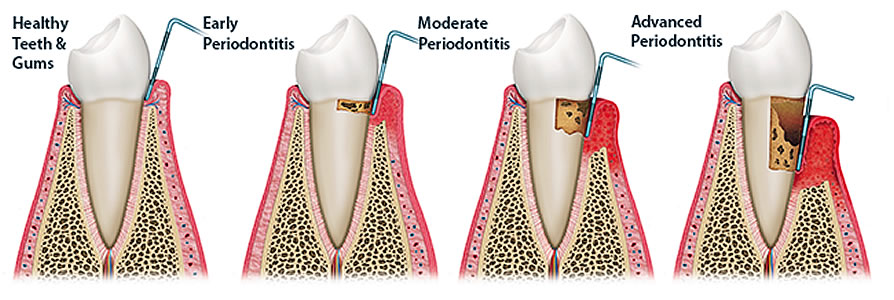 What is gum disease?
What is gum disease?
Gum disease describes swelling, soreness or infection of the tissues supporting the teeth. There are two main forms of gum disease: gingivitis and periodontal disease.
What is gingivitis?
Gingivitis means inflammation of the gums. This is when the gums around the teeth become very red and swollen. Often the swollen gums bleed when they are brushed during cleaning.
What is periodontal disease?
Long-standing gingivitis can turn into periodontal disease. There are a number of types of periodontal disease and they all affect the tissues supporting the teeth. As the disease gets worse the bone anchoring the teeth in the jaw is lost, making the teeth loose. If this is not treated, the teeth may eventually fall out. In fact, more teeth are lost through periodontal disease than through tooth decay.
Am I likely to suffer from gum disease?
Probably. Most people suffer from some form of gum disease, and it is the major cause of tooth loss in adults. However, the disease develops very slowly in most people, and it can be slowed down to a rate that should allow you to keep most of your teeth for life.
What is the cause of gum disease?
All gum disease is caused by plaque. Plaque is a film of bacteria which forms on the surface of the teeth and gums every day. Many of the bacteria in plaque are completely harmless, but there are some that have been shown to be the main cause of gum disease. To prevent and treat gum disease, you need to make sure you remove all the plaque from your teeth every day. This is done by brushing and flossing.
How will smoking affect my gums and teeth?
Smoking can also make gum disease worse. Patients who smoke are more likely to produce bacterial plaque, which leads to gum disease. The gums are affected because smoking causes a lack of oxygen in the bloodstream, so the infected gums fail to heal. Smoking causes people to have more dental plaque and for gum disease to progress more rapidly than in non-smokers. Gum disease still remains the most common cause of tooth loss in adults.
What happens if gum disease is not treated?
Unfortunately, gum disease progresses painlessly on the whole so that you do not notice the damage it is causing. However, the bacteria are sometimes more active and this makes your gums sore. This can lead to gum abscesses, and pus may ooze from around the teeth. Over a number of years, the bone supporting the teeth can be lost. If the disease is left untreated for a long time, treatment can become more difficult.
How do I know if I have gum disease?
The first sign is blood on the toothbrush or in the rinsing water when you clean your teeth. Your gums may also bleed when you are eating, leaving a bad taste in your mouth. Your breath may also become unpleasant.
What do I do if I think I have gum disease?
The first thing to do is visit your dentist for a thorough check-up of your teeth and gums. The dentist can measure the 'cuff' of gum around each tooth to see if there is any sign that periodontal disease has started. X-rays may also be needed to see the amount of bone that has been lost. This assessment is very important, so the correct treatment can be prescribed for you.
What treatments are needed?
Your dentist will usually clean your teeth thoroughly to remove the scale. You'll also be shown how to remove plaque successfully yourself, cleaning all surfaces of your teeth thoroughly and effectively. This may take a number of sessions with the dentist or hygienist.
What else may be needed?
Once your teeth are clean, your dentist may decide to carry out further cleaning of the roots of the teeth, to make sure that the last pockets of bacteria are removed. This is known as root planing. You may need the treatment area to be numbed before anything is done. Afterwards, you may feel some discomfort for up to 48 hours.
Once I have had periodontal disease, can I get it again?
The periodontal diseases are never cured. But can be controlled as long as you keep up the home care you have been taught. Any further loss of bone will be very slow and it may stop altogether. However, you must make sure you remove plaque every day, and go for regular check ups by the dentist and hygienist.
Dental Decay
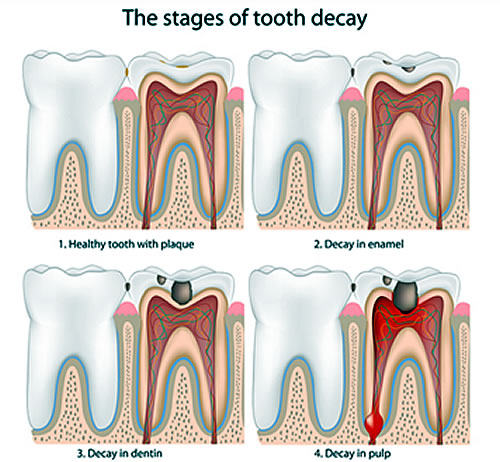 What is dental decay?
What is dental decay?
Dental decay happens when the enamel and dentine of a tooth become softened by acid attack, producing a cavity (hole).
What causes dental decay?
Dental decay is caused by plaque acids that gradually dissolve away the enamel and dentine of the tooth to produce a cavity. Dental decay is the same as tooth decay and is also known as "dental caries". Decay damages your teeth and may lead to the tooth needing to be filled or even extracted.
What is enamel?
Enamel is the hard protective outer coating of the tooth and is the hardest part of the body. It does not contain any nerves or blood vessels and is not sensitive to pain.
What is dentine?
Dentine lies under the enamel, forming most of the tooth and can be very sensitive to pain. Dentine covers the .central pulp of the tooth.
What is the pulp?
The pulp is a soft tissue which contains blood vessels and nerves and is in the middle of the tooth.
What is plaque?
Plaque is a thin, sticky film that keeps forming on your teeth. It contains many types of bacteria.
Why do my teeth decay?
A decay happens when sugars in food and drinks react with the bacteria in plaque, forming acids. Every time you eat or drink anything containing sugars, the bacteria react with it to form acid. These acids attack the teeth and start to dissolve the enamel. The attacks can last for an hour after eating or drinking, before the natural salts in your saliva cause the enamel to "remineralise" and harden again. It´s not just sugars that are harmful: other types of carbohydrate foods and drinks react with plaque and form acid (These are the "fermentable" carbohydrates such as the "hidden sugars" that can be added to processed food, natural sugars like those found in fruit, and cooked starches). Snacking on sugary or acidic foods and drinks can increase the risk of decay, as the teeth come under constant attack and do not have time to recover. It is therefore important not to keep snacking on sugary foods or sipping sugary drinks throughout the day.
What are the signs of dental decay?
In the early stages of dental decay there are no symptoms, but your dentist may be able to spot an early cavity when they examine or x-ray your teeth. This is why you should visit your dentist regularly, as small cavities are much easier to treat than advanced decay.
What happens if I have a cavity?
A Once the cavity has reached the dentine your tooth may become sensitive, particularly with sweet foods and drinks, and acidic or hot foods. As the decay gets near the dental pulp you may suffer from toothache. If the toothache is brought on by hot or sweet foods this may fast for only a few seconds. As the decay gets closer to the dental pulp the pain may last longer and you may need to take painkillers - paracetamol or ibuprofen - to control the pain. You must visit your dentist immediately as the tooth is dying and you may develop a dental abscess if it is not treated.
What happens if I don´t get it treated early?
Toothache is a sign that you should visit a dentist immediately, as it is a warning that something is wrong. If you don´t do anything, this will usually make matters worse, and you may lose a tooth that could otherwise have been saved.
What areas of my teeth are more likely to decay?
A The biting surfaces of the teeth and the surfaces between the teeth are most likely to decay, as food and plaque can become stuck in these areas.
What treatment will I need?
If the decay is not too serious, the dentist will remove all the decay and restore the tooth with a filling. Sometimes the nerve in the middle of the tooth can be damaged. If so the dentist will need to carry out root canal treatment by removing the nerve and then restoring the tooth with a filling or a crown. If the tooth is so badly decayed that it cannot be restored, the only option may be to extract the tooth.
Will I always need a filling?
No. In the very early stages of decay, your dentist may apply a fluoride varnish onto the area. This can help stop further decay and help "remineralise" the tooth. However, it is important to continue with a good oral hygiene routine, using fluoride toothpaste to prevent further decay developing.
Is there anything I can do to protect my teeth against decay?
As the adult molars appear, and if the tooth is free of decay, a "fissure sealant" can be used to protect the tooth. The sealant is a plastic coating that fills all the little crevices in the tooth surface, creating a flat surface that is easier to clean. This is called a "pit and fissure sealant". Adults can also have this treatment if the teeth are free of decay.
What can I do to prevent decay?
The best way to prevent dental decay is by brushing your teeth thoroughly twice a day with fluoride toothpaste, making sure that you brush the inner, outer and biting surfaces of your teeth. Using dental floss, tape or interdental aids also helps remove plaque and food from between your teeth and gumline. These are areas a toothbrush can´t reach.
Is there anything else I can do?
Visit your dentist regularly, as often as they recommend, and have sugary and acidic food and drinks less often. Avoid snacking between meals as this limits the times your teeth are under attack from acids. Chewing sugar-free gum for ten minutes after a meal can help your mouth produce more saliva, which helps to neutralise any acids which have been formed.
How can my dentist and hygienist help me prevent decay?
A Your dentist or hygienist will show you what areas you need to take most care of when cleaning. They will also show you how to brush and floss correctly.
Fluoride
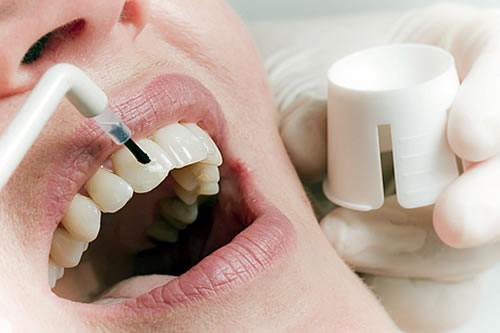 What is fluoride?
What is fluoride?
Fluoride is a natural mineral that is found in many foods and in all drinking water. The amount of fluoride in the water varies from area to area.
What are the benefits of fluoride?
Fluoride can greatly help dental health by strengthening the tooth enamel, making it more resistant to tooth decay. It also reduces the amount of acid that the bacteria on your teeth produce. Children who have fluoride when their teeth are developing tend to have shallower grooves in their teeth so plaque can be more easily removed. Plaque is a thin, sticky film of bacteria that constantly forms on your teeth. The addition of fluoride to water has been researched for over 50 years, and water fluoridation has been proven to reduce decay by 40-60%.
Where can I find fluoride?
Fluoride is found naturally in many foods and water supplies, and is also added to some drinking water supplies. One part of fluoride for every million parts of water (1 ppm) has been shown to have the best effect.
All water contains some fluoride. Your local water supplier can tell you the level of fluoride in your drinking water.
Is there enough fluoride in my water supply?
Possibly. However, only a few places (Hartlepool in the North East of England, and parts of Essex) have enough natural fluoride to benefit dental health. Elsewhere it is added to only around 10% of the UK population´s water supply - mainly in the West Midlands and the North East. Your water supplier will be able to tell you whether your water supply is fluoridated. The amount of fluoride in the water will vary depending on which area you live in. Fluoride is also naturally present in foods and drinks such as fish and tea, and some countries add fluoride to their table salt and milk instead of fluoridating the water supplies. One cup of tea can contain between 0.3mg and 0.5mg of fluoride, and if you drink it with milk your teeth will also benefit from the calcium. It is best to drink tea without sugar to reduce the risk of dental decay further.
What about fluoride toothpaste?
Most toothpastes now contain fluoride, and most people get their fluoride this way. Fluoride toothpaste is very effective in preventing tooth decay. The amount of fluoride in toothpaste is usually enough to lower the level of decay. In areas where the water supply is fluoridated, fluoride toothpaste gives extra protection. Parents should supervise their children´s tooth brushing, and use only a smear or pea-sized amount of fluoride toothpaste until they are about 7 years old.
Should people have extra fluoride?
Children living in poorer areas where the water supplies are not fluoridated can have 5 times more decay than children living in better-off or fluoridated areas. Research suggests that adding fluoride to the water is the best way of reducing these "dental inequalities". Your dentist or dental hygienist can apply fluorides to your teeth. These come as gels and are more concentrated than self-applied fluorides, and therefore are not needed as often. Some adults can benefit from these applications. Fluoride gels can help to reduce root decay - especially in people with dry mouth. Some people are more prone to tooth decay, and the dentist may also advise using fluoride supplements as well as fluoride toothpaste for extra protection. It is very important that fluoride supplements are only taken on the advice of a dentist, and that they are used in the way they say. Supplements are suitable for children from about 3 onwards and can help reduce decay.
What are the side effects?
`Dental fluorosis' is caused by having too much fluoride when the teeth are developing. This can happen when fluoride supplements are taken by children under 7 who live in areas where the water supply is fluoridated. It can also happen when children swallow toothpaste.
What is fluorosis?
In its mildest form, dental fluorosis appears as very fine pearly white lines or flecking on the surface of the teeth. This mild fluorosis can often only be spotted by a dental expert. Severe fluorosis may lead to the enamel being pitted and discoloured.
Fortunately, severe fluorosis is rare in the UK.
Is fluoride safe?
Many reports have been published throughout the world about the pros and cons of fluoride. After many years the scientific conclusion is that fluoride toothpaste and correctly fluoridated water, salt and milk are of great benefit to dental health and help to reduce decay, and cause no harmful side effects to general health. Recent studies carried out for the government by York University and the Medical Research Council have failed to find any evidence that fluoride added to water causes harmful side effects.
Opponents of fluoridation claim they have firm evidence that fluoride added to water is harmful. However, scientific analysis has not supported their claims.
Worldwide, over 300 million people drink fluoridated water supplies. Many millions more regularly use fluoridated toothpaste. In America for example, well over half of the population have fluoridated water supplies. This has led to improved levels of dental health which in turn benefits general health.
Pit and Fissure Sealants
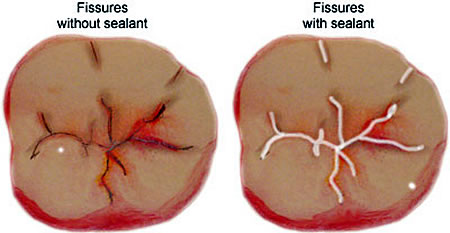 What are sealants?
What are sealants?
Sealants are a safe and painless way of protecting your children´s teeth from decay. A sealant is a protective plastic coating, which is applied to the biting surfaces of the back teeth. The sealant forms a hard shield that keeps food and bacteria from getting into the tiny grooves in the teeth and causing decay.
Which teeth should be sealed?
Sealants are only applied to the back teeth - the molars and premolars. These are the teeth that have pits and fissures on their biting surfaces. Your dentist will tell you which teeth should be sealed after they have examined them, and checked whether the fissures are deep enough for sealing to help. Some teeth naturally form with deep grooves which can be sealed, others with shallow ones which may not need sealing.
What is involved?
The process is usually quick and straightforward taking only a few minutes per tooth. The tooth is thoroughly cleaned, prepared with a special solution, and dried. The liquid sealant is then applied and allowed to set hard - usually by shining an ultraviolet light onto it.
Will my child feel it?
No, it is totally pain free, and the teeth do not feel any different afterwards.
How long do they last?
Sealants usually last for many years, but your dentist will want to check them regularly to make sure that the seal is still intact. They can wear over time, and sometimes the dentist needs to add or replace some sealants to be sure that no decay can start underneath them.
How do they work?
The sealant forms a smooth, protective barrier, by covering all the little grooves and dips in the surface of the tooth. Dental decay easily starts in these grooves.
When should this be done?
Sealants are often applied as soon as the permanent teeth start to come through. This is usually between 6 and 7 years of age. The rest are usually sealed as soon as they appear which can be any time between 11 and 14 years of age.
How much does it cost?
Most dentists offer fissure sealing. In many cases it is available only privately. The cost varies from dentist to dentist, but it is usually good value. Ask for a written estimate of the cost before you start any treatment.
The tooth surface is cleaned, conditioned and dried Sealant is dropped onto the tooth surface and flows into position Sealant sticks to the tooth and is hardened under a blue light. The tooth is sealed giving full protection.
Do my children still have to clean their teeth?
Yes. It is still vital that they do this. The smooth, sealed surface is now much easier to keep clean and healthy with normal toothdrushing. Using a fluoride toothpaste will also help to protect your children´s teeth. Pit and fissure sealing reduces tooth decay and the number of fillings your child might need.
Whom do I ask about the treatment?
If you would like to know more about the treatment, ask your dentist or hygienist. They will tell you if fissure sealing will help your children´s teeth, and if it is the right time to do it.
Sensitive Teeth
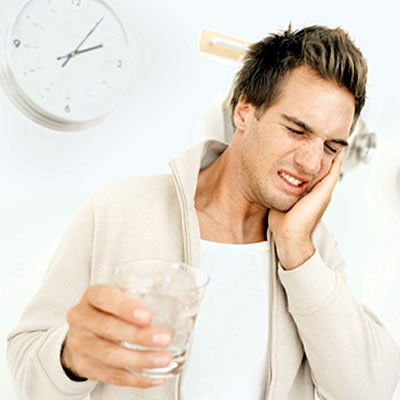 What are sensitive teeth?
What are sensitive teeth?
Having sensitive teeth can mean anything from getting a mild twinge to having severe discomfort that can continue for several hours.
It can also be an early warning sign of more serious dental problems.
Who suffers from sensitive teeth?
Many people suffer from sensitive teeth and it can start at any time. It is more common in people aged between 20 and 40, although it can affect people in their early teens and when they are over 70. Women are more likely to be affected than men.
What causes sensitive teeth?
The part of the tooth we can see is covered by a layer of enamel that protects the softer dentine underneath.
If the dentine is exposed, a tooth can become sensitive. This usually happens where the tooth and the gum meet and the enamel layer is much thinner.
Here are some causes of sensitivity:
- Toothbrush abrasion - brushing too hard, and brushing from side to side, can cause enamel to be worn away, particularly where the teeth meet the gums. The freshly exposed dentine may then become sensitive.
- Dental erosion - this is loss of tooth enamel caused by attacks of acid from acidic food and drinks. If enamel is worn away the dentine underneath is exposed, which may lead to sensitivity.
- Gum recession - gums may naturally recede (shrink back), and the roots will become exposed and can be more sensitive. Root surfaces do not have an enamel layer to protect them.
- Gum disease - a build-up of plaque or tartar can cause the gum to recede down the tooth and even destroy the bony support of the tooth. Pockets can form in the gums around the tooth, making the area difficult to keep clean and the problem worse.
- Tooth grinding - this is a habit which involves clenching and grinding the teeth together. This can cause the enamel of the teeth to be worn away, making the teeth sensitive.
Other causes of pain from sensitivity may be:
- Cracked tooth or filling - a cracked tooth is one that has become broken. A crack can run from the biting surface of a tooth down towards the root. Extreme temperatures, especially cold, may cause discomfort.
- Tooth bleaching - some patients have sensitivity for a short time during or after having their teeth bleached. Discuss this with your dentist before having treatment.
When are teeth more likely to be sensitive?
You are more likely to feel the sensitivity when drinking or eating something cold, from cold air catching your teeth, and sometimes with hot foods or drinks. Some people have sensitivity when they have sweet or acidic food and drink. The pain can come and go, with some times being worse than others.
Is there anything I can do to treat sensitive teeth at home?
There are many brands of toothpaste on the market made to help ease the pain of sensitive teeth. The toothpaste should be used twice a day to brush your teeth. It can also be rubbed onto the sensitive areas.
These toothpastes can take anything from a few days to several weeks to take effect. Your dentist should be able to advise you on which type of toothpaste would be best for you.
Is there anything I should avoid if I have sensitive teeth?
You may find that hot, cold, sweet or acidic drinks, or foods like ice cream can bring on sensitivity, so you may want to avoid these. If you have sensitivity when brushing your teeth with cold water from the tap, you may need to use warm water instead. It is important you do not avoid brushing your teeth regularly as this could make the problem worse.
Do I need to go and see my dentist?
Yes, if you have tried treating your sensitive teeth for a few weeks and have had no improvement.
What treatments can the dentist offer?
During an examination the dentist will talk to you about your symptoms. They will look at your teeth to find out what is causing the sensitivity and to find the best way of treating it. The dentist may treat the affected teeth with special de-sensitising products to help relieve the symptoms. Fluoride gels, rinses or varnishes can be applied to sensitive teeth. These can be painted onto the teeth at regular appointments one or two weeks apart, to build up some protection. Sensitivity can take some time to settle, and you may need to have several appointments. If this still does not help, your dentist may seal or fill around the neck of the tooth, where the tooth and gum meet, to cover exposed dentine. In very serious cases it may be necessary to rootfill the tooth.
How can I prevent sensitive teeth?
Brush your teeth twice a day for two minutes with fluoride toothpaste. Use small circular movements with a soft - to medium-bristled brush. Try to avoid brushing your teeth from side to side. Change your toothbrush every two to three months, or sooner if it becomes worn. Have sugary foods, and fizzy and acidic drinks less often. Try to have them only at mealtimes. If you grind your teeth, talk to your dentist about the possibility of having a mouthguard made to wear at night. If you are thinking about having your teeth bleached, discuss sensitivity with your dentist before starting treatment.
Visit your dentist regularly, as often as they recommend.
Bad Breath
 How can I tell if I have bad breath?
How can I tell if I have bad breath?
Lots of small signals can show that you have bad breath. Have you noticed people stepping away when you start to talk? Do people turn their cheek when you kiss them goodbye? If you think you might have bad breath, there is a simple test that you can do. Simply lick the inside of your wrist and sniff - if the smell is bad, you can be pretty sure that your breath is too. Or, ask a very good friend to be absolutely honest, but do make sure they are a true friend.
What causes bad breath?
A bad breath is a very common problem and there are many different causes. Persistent bad breath is usually caused by the smelly gases released by the bacteria that coat your teeth and gums.
Bits of food that get caught between the teeth and on the tongue will decay and can sometimes cause an unpleasant smell. So correct and regular brushing is very important to keep your breath smelling fresh. However, strong foods like garlic, coffee and onions can add to the prblem. The bacteria on our teeth and gums (plaque) also cause gum disease and dental decay. One of the warning signs of gum disease is that you always have bad breath or a bad taste in your mouth. Again, your dentist or hygienist will be able to see and treat the problem during your regular check-ups. The earlier the problems are found, the more effective the treatment will be.
What else causes bad breath?
Bad breath can also be caused by some medical problems. Dry mouth (xerostomia) is a condition that affects the flow of saliva. This causes bacteria to build up in the mouth and this leads to bad breath. Dry mouth may be caused by some medicines, salivary gland problems or by continually breathing through the mouth instead of the nose. Older people may produce less saliva, causing further problems. If you suffer from dry mouth, your dentist may be able to recommend or prescribe an artificial saliva product. Or your dentist may be able to suggest other ways of dealing with the problem.
Can other medical conditions cause bad breath?
Other medical conditions that cause bad breath include infections in the throat, nose or lungs; sinusitis; bronchitis; diabetes; or liver or kidney problems. If your dentist finds that your mouth is healthy, you may be referred to your family GP or a specialist to find out the cause of your bad breath.
Can smoking cause bad breath?
Tobacco also causes its own form of bad breath. The only solution in this case is to stop smoking. As well as making your breath smell, smoking causes staining, causes loss of taste and irritates the gums. People who smoke are more likely to suffer from gum disease and also have a greater risk of developing cancer of the mouth, lung cancer and heart disease.
Ask your dentist, pharmacist or practice nurse for help in quitting. If you do stop smoking, but still have bad breath, then you need to see your dentist or GP for advice.
How can my dentist help?
If you do have bad breath, you will need to start a routine for keeping your mouth clean and fresh. Regular check-ups will allow your dentist to watch out for any areas where plaque is caught between your teeth. Your dentist or hygienist will be able to clean all those areas that are difficult to reach. They will also be able to show you the best way to clean your teeth and gums, and show you any areas you may be missing, including your tongue.
Can I prevent bad breath?
To keep your breath fresh, you must get rid of any gum disease, and keep your mouth clean and fresh. If you do have bad breath, try keeping a diary of all the foods you eat and list any medicines you are taking. Take this diary to your dentist who may be able to suggest ways to solve the problem.
Brush your teeth and gums twice a day with fluoride toothpaste. Don´t forget to brush your tongue as well.
Cut down on how often you have sugary snacks and drinks.
Changing your diet can help prevent bad breath.
Visit your dentist at least once a year.
- Floss your teeth - brushing alone only cleans up to about 60 percent of the surface of your teeth. There are other products you can buy to clean between your teeth (they are called "interdental brushes").
- Use a mouthwash - some contain antibacterial agents that could kill bacteria that make your breath smell unpleasant. If you continue to suffer from bad breath visit your dentist or hygienist to make sure that the mouthwash is not masking a more serious underlying problem. Chew sugar-free gum - it stimulates saliva and stops your mouth drying out. A dry mouth can lead to bad breath.
Will mouthwash help?
Most mouthwashes only disguise bad breath for a short time. So if you find that you are using a mouthwash all the time, talk to your dentist. Some mouthwashes that are recommended for gum disease can cause tooth staining if you use them for a long time. It is important to read the instructions or ask your dentist how to use them.
How can I prevent bad breath if I wear dentures?
Take them out at night to give your mouth a chance to rest and clean them twice a day. Clean them thoroughly with soap and lukewarm water, a denture cream or a denture-cleaning tablet. Use a denture brush kept just for the purpose. Remember to clean the surfaces that fit against your gums and palate. This will make sure your dentures are always fresh and clean, and avoid the plaque build-up on the denture that may cause bad breath.
How can I tell someone they have bad breath?
The chances are, we all know someone who has bad breath, but very few people feel brave enough to discuss the problem. It is obviously a very delicate matter to tell someone they have bad breath. There is always the risk that they will be offended or embarrassed and may never speak to you again! However, bad breath may be the result of any number of problems. Once the person knows they have bad breath, they can deal with whatever is causing it. You could try talking to their partner or a family member, as the bad breath may be caused by a medical condition, which is already being treated. You may like to leave this leaflet where the person in question is likely to see it. Or you could try a more subtle approach, for instance asking if the person has been eating garlic lately!
Children Teeth
 When should I take my child to the dentist?
When should I take my child to the dentist?
It is recommended that children should go to the dentist with their parents as soon as possible. You should then take them regularly, as often as your dentist recommends. This will let them get used to the noises, smells and surroundings and prepare them for future visits. The earlier these visits begin, the more relaxed the children will be.
Teach your children how to clean their teeth.
When will my child´s teeth come through?
First or "baby" teeth have usually developed before your child is born and will start to come through at around 6 months. All 20 baby teeth should be through by the age of two-and-a-half (for more information, see our Tell me about Dental Care for Mother and Baby leaflet). The first permanent "adult" molars (back teeth) will appear at about 6 years of age, behind the baby teeth and before the first teeth start to fall out at about 6 to 7. The adult teeth will then replace the baby teeth. It is usually the lower front teeth that are lost first, followed by the upper front teeth shortly after. All adult teeth should be in place by the age of 13, except the wisdom teeth. These may erupt any time between 18 and 25 years of age. All children are different and develop at different rates. The diagram to the right gives an idea of where the adult teeth come through.
How should I clean my child´s teeth?
Cleaning your child´s teeth should be part of their daily hygiene routine. You may find it easier to stand or sit behind your child, cradling their chin in your hand so you can reach their top and bottom teeth more easily. When the first teeth start to come through, try using a children´s toothbrush with a small smear of toothpaste. It is important to supervise your child´s brushing until they are at least seven. Once all the teeth have come through, use a small-headed soft toothbrush in small circular movements and try to concentrate on one section at a time.
Don´t forget to brush gently behind the teeth and onto the gums. If possible make tooth brushing a routine - preferably in the morning, and last thing before your child goes to bed. Remember to encourage your child, as praise will often get results!
Should I use fluoride toothpaste?
Fluoride comes from a number of different sources including toothpaste, specific fluoride applications and perhaps the drinking water in your area. These can all help to prevent tooth decay. If you are unsure about using fluoride toothpaste ask your dentist, health visitor or health authority. The current advice is to use a pea-sized smear of a toothpaste containing at least 1000ppm of fluoride. You can check the level of fluoride on the packaging of the toothpaste. Children should be supervised up to the age of 7, and you should make sure that they spit out the toothpaste and don´t swallow any if possible.
What sort of brush should I use?
There are many different types of children´s toothbrushes available, including brightly coloured brushes, some of which change colour, those with favourite characters on the handles, and some with timers. These all encourage children to brush their teeth. The most important point is to use a small-headed toothbrush with soft, nylon bristles, suitable for the age of your child.
What could cause my child to have toothache?
Toothache is painful and upsetting, especially in children, and the main cause is still tooth decay. This is due to too much sugar, too often, in the diet. Teething is another problem that starts at around 6 months and can continue as all the adult teeth start to come through. If your child needs pain relief, make sure you choose a sugar-free medicine and also remember to check with the doctor or pharmacist that you are being prescribed sugar-free medicines at all times. If the pain continues then contact your dentist for an appointment.
How can I prevent tooth decay in my child?
The main cause of tooth decay is not the amount of sugar in the diet, but how often it is eaten or drunk. The more often your child has sugary foods or drinks, the more likely they are to have decay. It is therefore important to keep sugary foods to mealtimes only. If you want to give your child a snack, try to stick to cheese, vegetables and fruit, but not dried fruit. It is also worth remembering that some processed baby foods contain quite a lot of sugar. Try checking the list of ingredients: the higher up the list sugar is, the more there is in the product. Sometimes, these are shown as fructose, glucose, lactose, or sucrose. Thorough brushing twice a day, particularly last thing at night, will help to prevent tooth decay.
What if my child is very nervous about going to the dentist?
Children can sense fear in their parents, so it is important not to let your child feel that a visit to the dentist is something to be worried about. Try to be supportive if your child needs to have any dental treatment. If you have any fears of your own about going to the dentist, don´t discuss them in front of your child. Regular visits to the dentist are essential in helping your child to get used to the surroundings and what goes on there. A child can be much more anxious if it is their first visit to a dental practice. Pain and distress can happen at any time and it is important to prepare your child with regular visits.
Tooth Whitening
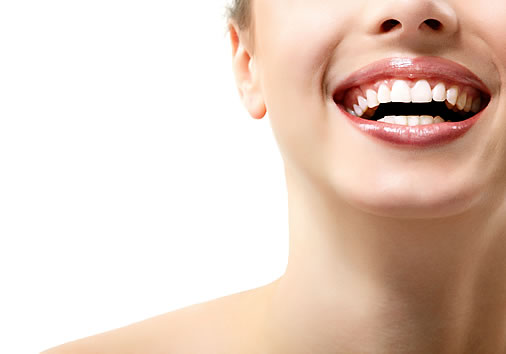 What is tooth whitening?
What is tooth whitening?
Tooth whitening can be a highly effective way of lightening the natural colour of your teeth without removing any of the tooth surface. It cannot make a complete colour change; but it may lighten the existing shade.
Why would I need my teeth whitened?
There are a number of reasons why you might get your teeth whitened. Everyone is different; and just as our hair and skin colour vary, so do our teeth. Very few people have brilliant-white teeth, and our teeth can also become more discoloured as we get older. Your teeth can also be stained on the surface through food and drinks such as tea, coffee, red wine and blackcurrant. Smoking can also stain teeth. Calculus or tartar can also affect the colour of teeth. Some people may have staining under the surface, which can be caused by certain antibiotics or tiny cracks in the teeth which take up stains.
What does tooth whitening involve?
Professional bleaching is the most common form of tooth whitening. Your dentist will be able to tell you if you are suitable for the treatment, and will supervise it if you are. First the dentist will put a rubber shield or a gel on your gums to protect the soft tissue. They will then apply the whitening product to your teeth, using a specially made tray which fits into your mouth like a gum-shield.
The "active ingredient" in the product is usually hydrogen peroxide or carbamide peroxide. As the active ingredient is broken down, oxygen gets into the enamel on the teeth and the tooth colour is made lighter.
How long does this take?
The total treatment can usually be done within three to four weeks. First, you will need two or three visits to the dentist. Your dentist will need to make a mouthguard and will take impressions for this at the first appointment. Once your dentist has started the treatment, you will need to continue the treatment at home. This means regularly applying the whitening product over two to four weeks, for 30 minutes to one hour at a time.
However, there are now some new products which can be applied for up to eight hours at a time. This means a satisfactory result can be achieved in as little as one week.
What other procedures are there?
There is now laser whitening or "power whitening". During this procedure a rubber dam is put over your teeth to protect the gums, and a bleaching product is painted onto your teeth. Then a light or laser is shone on the teeth to activate the chemical. The light speeds up the chemical reaction of the whitening product and the colour change can be achieved more quickly using this procedure. Laser whitening is said to make teeth up to five or six shades lighter.
How long does this take?
Your dentist will need to assess your teeth to make sure that you are suitable for the treatment. Once it has been agreed, this procedure usually takes about one hour.
How much does tooth whitening cost?
You cannot get whitening treatments on the NHS. Private charges will vary from practice to practice and region to region. Laser or power whitening will be more expensive than professional bleaching. We recommend you get a written estimate of the cost before you start any treatment.
How long will my teeth stay whiter?
The effects of whitening are thought to last up to three years. However, this will vary from person to person. The effect is less likely to last as long if you smoke, or eat or drink products that can stain your teeth. Ask your dentist for their opinion before you start the treatment.
What are the side effects?
Some people may find that their teeth become sensitive to cold during or after the treatment. Others report discomfort in the gums, a sore throat or white patches on the gum line. These symptoms are usually temporary and should disappear within a few days of the treatment finishing. If any of these side effects continue you should go to your dentist.
Can a single tooth which has been root filled be whitened?
Sometimes. Many dead teeth go discoloured after a root filling. If the tooth has been root treated, the canal (which previously contained the nerve) may be reopened. The whitening product is applied working from the inside to whiten the tooth.
When might tooth whitening not work?
Tooth whitening can only lighten your existing tooth colour. Also it only works on natural teeth. It will not work on any types of "false" teeth such as dentures, crowns and veneers. If your dentures are stained or discoloured visit your dentist and ask for them to be cleaned. Stained veneers, crowns or dentures may need replacing; again ask your dentist.
Wisdom Tooth
Why do we have wisdom teeth?
Adults can have a maximum of 32 teeth. The wisdom teeth or third molars are the last to come through, right at the back. They usually appear between the ages of 17 and 25. Although sometimes they appear many years later. Nowadays people often have jaws that are too small for all 32 teeth - 28 is often the most we have room for. So if all the other teeth are present and healthy there may not be enough space for the wisdom teeth to come through properly.
Do they always cause problems?
No. If there is enough room they will usually come through into a useful position and cause no more problems than any other tooth. Often there will be some slight discomfort as they come through, but this is only temporary and will disappear once the tooth is fully in position.
What is an impacted wisdom tooth?
If there is not enough room, the wisdom tooth may try to come through, but will get stuck against the tooth in front of it. The wisdom tooth will be at an angle, and will be described by the dentist as "impacted".
What problems should I be prepared for?
If part of the wisdom tooth has appeared through the gum and part of it is still covered, the gum may become sore and perhaps swollen. Food particles and bacteria can collect under the gum edge, and it will be difficult to clean the area effectively. This is known as pericoronitis. This is a temporary problem that can be dealt with by using mouthwashes and special cleaning methods and possibly antibiotics. If the problem keeps coming back, it may be better to have the tooth removed.
What can I do to help myself?
A mouthwash of medium hot water with a teaspoonful of salt will help to reduce gum soreness and inflammation (check that it is not too hot before using it). Swish the salt water around the tooth, trying to get into the areas your toothbrush cannot reach. This should be done several times a day. An antibacterial mouthwash containing chlorhexidine can also reduce the inflammation. Pain-relieving tablets such as paracetamol or aspirin can also be useful in the short term, but consult your dentist if the pain continues. These should always be swallowed and in no circumstances be placed on the area.
But if it does not help?
If the pain does not go away or if you find it difficult to open your mouth, you should see a dentist. They will be able to see the cause of the problem, and advise you accordingly. It may be useful to clean around the tooth very thoroughly, and an antibiotic may be prescribed.
Are x-rays needed?
The dentist will usually take x-rays to see the position of the root, and to assess whether there is room for the tooth to come through into a useful position.
What are the main reasons for taking wisdom teeth out?
Far fewer wisdom teeth are now taken out than in the past. If the tooth is not causing problems, your dentist will not want to remove it.
They will only remove wisdom teeth:
- when it is clear that they will not be able to come through into a useful position because there is not enough room, and they are also causing some pain or discomfort
- if they have only partly come through and are decayed - such teeth will often decay as it will be difficult to clean them as thoroughly as your other teeth
- if they are painful.
Are wisdom teeth difficult to take out?It all depends on the position and the shape of the roots. Your dentist will advise you as to how easy or difficult each tooth will be to remove after looking at the x-rays. Upper wisdom teeth are often more straight forward to remove than lower ones, which are more likely to be impacted. Your dentist will advise you whether the tooth should be taken out at the dental practice, or whether you should be referred to a specialist (oral surgeon) at a hospital. Very occasionally there is a possibility of some numbness of the lip after the removal of a lower tooth - your dentist will tell you if it is possible in your case. Either local anaesthetic - as you would have for a filling - or sedation will probably be recommended. A general anaesthetic (where you would be asleep) can also be used, but this will only be given in a hospital.
Will it make any difference to my face or mouth?
Removing wisdom teeth may produce some swelling for a few days but as soon as the area is healed, there will be no difference to your face or appearance. Your mouth will feel more comfortable and less crowded, especially if the teeth are impacted.
What should I expect after a wisdom tooth is taken out?
The amount of discomfort will depend on how easy the removal of the tooth was. There is usually some swelling and discomfort for a few days afterwards, and it is important to follow any advice you get about mouthwashes etc, to help with the healing. Some people also find homeopathic remedies help to reduce discomfort. Usual pain-killers such as paracetamol, aspirin or ibuprofen will usually deal with any pain. It is best to stay fairly quiet and relaxed and avoid smoking and drinking for 24 hours afterwards to make sure there are no bleeding problems. There may be some stitches to help the gum heal over - your dentist will probably want to see you again about a week later to check on the healing, and to remove any stitches.
Will it make any difference to my face or mouth?
Removing wisdom teeth may produce some swelling for a few days but as soon as the area is healed, there will be no difference to your face or appearance. Your mouth will feel more comfortable and less crowded, especially if the teeth are impacted.
What to do following an extraction
I´ve had my tooth out - what should I do now?
Take it easy for the rest of the day. Take as little exercise as you can, and rest as much as you can. Keep your head up to avoid any bleeding.
What precautions should I take?
Avoid hot food or drinks until the anaesthetic wears off. This is important as you cannot feel pain properly and may burn or scald your mouth. Also be careful not to chew your cheek. This is quite a common problem, which can happen when there is no feeling. If you do rest, try to keep your head higher for the first night using an extra pillow if possible. It is also a good idea to use an old pillowcase, or put a towel on the pillow, in case you bleed a little.
Should I rinse my mouth out?
Do not be tempted to rinse the area for the first 24 hours. It is important to allow the socket to heal, and you must be careful not to damage the blood clot by eating on that side or letting your tongue disturb it. This can allow infection into the socket and affect healing.
Avoid alcohol and hot drinks.
Is there anything else I should avoid?
Avoid alcohol for at least 24 hours, as this can encourage bleeding and delay healing. Eat and drink lukewarm food as normal but avoid chewing on that area of your mouth.
When should I brush?
It is just as important, if not more so, to keep your mouth clean after an extraction. However, you do need to be careful around the extraction site.
What do I do if it bleeds?
The first thing to remember is that there may be some slight bleeding for the first day or so. Many people are concerned about the amount of bleeding. This is due to the fact that a small amount of blood is mixed with a larger amount of saliva, which looks more dramatic than it is. If you do notice bleeding, do not rinse out, but apply pressure to the socket. Bite firmly on a folded piece of clean dampened cotton material such as a handkerchief for at least 15 minutes. Make sure this is placed directly over the extraction site and that the pad is replaced if necessary. If the bleeding has not stopped after an hour or two, contact your dentist.
How soon can I have a cigarette?
It is important not to do anything which will increase your blood pressure, as this can lead to further bleeding. We recommend that you avoid smoking for as long as you can after an extraction, but this should be at least for the rest of the day.
Is there anything I can do to help my mouth?
Different people heal at different speeds after an extraction. It is important to keep your mouth and the extraction site as clean as possible, making sure that the socket is kept clear of all food and debris. Don´t rinse for the first 24 hours, and this will help your mouth to start healing. After this time use a salt-water mouthwash, which helps to heal the socket. A teaspoon of salt in a glass of warm water gently rinsed around the socket twice a day can help to clean and heal the area. Keep this up for at least a week or for as long as your dentist tells you. It is important to keep to a healthy diet; and take a Vitamin C supplement, which will help your mouth to heal.
Take it easy after having your tooth out.
I am in pain, what should I take?
There will usually be some tenderness in the area for the first few days, and in most cases some simple pain relief is enough to ease the discomfort. What you would normally take for a headache should be enough. However, always follow the manufacturer´s instructions and if in doubt check with your doctor first. Do not take aspirin, as this may make your mouth bleed.
Are there any medicines I should avoid?
As we have said, it is important not to use anything containing aspirin as this can cause further bleeding. This happens because aspirin can thin the blood slightly. Asthma sufferers should avoid Ibuprofen-based pain relief. Again check with your chemist or dentist if you are worried or feel you need something stronger.
I am still in pain, what could it be?
Sometimes an infection can get in the socket, which can be very painful. This is where there is little or no blood clot in the tooth socket and the bony socket walls are exposed and become infected. This is called a dry socket and in some cases is worse than the original toothache! In this case, it is important to see your dentist, who may place a dressing in the socket and prescribe a course of antibiotics to help relieve the infection. You may also feel the sharp edge of the socket with your tongue and sometimes small pieces of bone may work their way to the surface of the socket. This is perfectly normal.
Will my dentist need to see me again?
If it has been a particularly difficult extraction, the dentist will give you a follow-up appointment. This could be to remove any stitches that were needed, or simply to check the area is healing well.
Root Canal Treatment
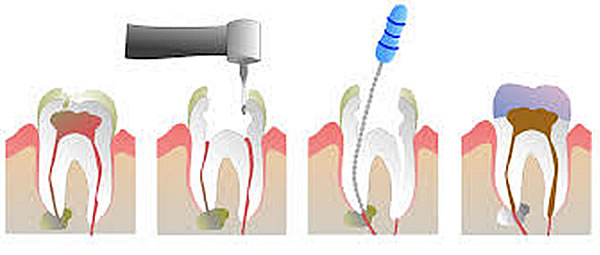 What is root canal treatment?
What is root canal treatment?
Root canal treatment (also called endodontics) is needed when the blood or nerve supply of the tooth (known as the pulp) is infected through decay or injury. You may not feel any pain in the early stages of the infection. In some cases, your tooth could darken in colour which may mean that the nerve of the tooth has died (or is dying). This would need root canal treatment.
Why is root canal treatment needed?
If the pulp becomes infected, the infection may spread through the root canal system of the tooth. This may eventually lead to an abscess. An abscess is an inflamed area in which pus collects and can cause swelling of the tissues around the tooth. The symptoms of an abscess can range from a dull ache to severe pain and the tooth may be tender when you bite. If root canal treatment (RCT) is not carried out, the infection will spread and the tooth may need to be taken out.
Does it hurt?
No. Usually, a local anaesthetic is used and it should feel no different to having an ordinary filling done.
What does it involve?
The aim of the treatment is to remove all infection from the root canal. The root is then cleaned and filled to prevent any further infection. Root canal treatment is a skilled and time-consuming procedure. Most courses of treatment will involve two or more visits to your dentist.
At the first appointment, the infected pulp is removed. Any abscesses, which may be present, can also be drained at this time. The root canal is then cleaned and shaped ready for the filling. A temporary filling is put in and the tooth is left to settle.
The tooth is checked at a later visit and when all the infection has cleared, the tooth is permanently filled.
What will my tooth look like after treatment?
In the past, a root filled tooth would often darken after treatment. However, with modern techniques this does not usually happen. If there is any discolouration, there are several treatments available to restore the natural appearance.
What if it happens again?
A Root canal treatment is usually very successful. However, if the infection comes back the treatment can be repeated.
What if I don´t have the treatment?
The alternative is to have the tooth out. Once the pulp is destroyed, it can´t heal and it is not recommended to leave an infected tooth in the mouth.
Although some people would prefer an extraction, it is usually best to keep as many natural teeth as possible.
Will the tooth be safe after treatment?
Yes. However, as a dead tooth is more brittle, it may be necessary to restore the tooth with a crown to provide extra support and strength to the tooth.
Dentures
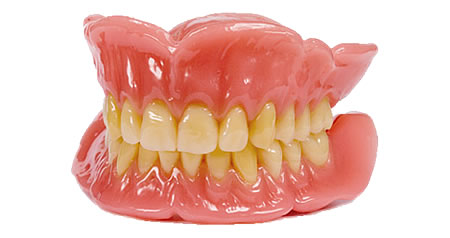 What is a denture?
What is a denture?
People wear dentures to replace lost or missing teeth so they can enjoy a healthy diet and smile with confidence. Dentures are made of either acrylic (plastic) or metal.
A "complete" or "full" denture is one which replaces all the natural teeth in either the upper or lower jaws.
A "partial" denture fills in the spaces left by lost or missing teeth. It may be fastened to your natural teeth with metal clasps or "precision attachments".
How soon can I have a denture after my teeth are taken out?
Usually dentures can be fitted straight after your teeth have been removed. These are called "immediate dentures". You visit the dentist beforehand for them to take measurements and impressions of your mouth. With immediate dentures you don´t have to be without teeth while your gums are healing. However, bone and gums can shrink over time, especially during the first six months after your teeth have been taken out. If your gums shrink, your immediate dentures may need relining, adjusting or even replacing. Your dentist will be able to discuss this with you. Sometimes your dentist may advise you to wait until your gums are healed before having your dentures, as this can sometimes provide a better fit. Healing may take several months.
Will dentures make me feel different?
Replacing lost or missing teeth is very good for your health and appearance. A complete or full denture replaces your natural teeth and gives support to your cheeks and lips. Without this support, sagging facial muscles can make a person look older and they will find it harder to eat and speak properly. Dentures can be made to closely match your natural teeth so that your appearance hardly changes. Modern dentures may even improve the look of your smile and help fill out the appearance of your face.
Will I be able to eat with dentures?
Eating will take a little practice. Start with soft foods cut into small pieces. Chew slowly using both sides of your mouth at the same time to stop the denture from moving. As you become more used to your denture, add other foods until you get back to your normal healthy diet.
Will dentures change how I speak?
Pronouncing certain words may take practice. Reading out loud and repeating difficult words will help. If you find that your dentures occasionally slip when you laugh, cough or smile, reposition them by gently biting down and swallowing. If this continues see your dentist.
How long should I wear my dentures?
During the first few days, your dentist may advise you to wear them for most of the time, including while you are asleep. After your mouth gets used to your dentures your dentist may advise that you take them out before going to bed. This allows your gums to rest and helps keep your mouth healthy.
Should I use a denture fixative?
Dentures are custom made to fit your mouth and you shouldn´t need a denture fixative. However, over time, dentures may become loose and not fit as well. When this happens, some people prefer to use a fixative for a short time before having them replaced. A poorly fitting denture may cause irritation and sores. This can often happen if you have worn immediate dentures for some time.
Must I do anything special to care for my mouth?
Even with full dentures, you still need to take good care of your mouth. Every morning and evening, brush your gums, tongue and the roof of your mouth with a soft-bristled brush. This removes plaque and helps the circulation in your mouth.
If you wear partial dentures, it is even more important that you brush your teeth thoroughly every day. This will help stop tooth decay and gum disease that can lead to you losing more of your teeth. Your dentist may refer you to the hygienist to have your remaining natural teeth cleaned regularly.
How do I take care of my dentures?
Dentures are very delicate and may break if you drop them. Always dean them over a bowl of water or a folded towel in case you drop them. To clean your dentures, the general rule is: brush, soak, brush. Brush your dentures before soaking, to help remove any food debris. Use an effervescent (fizzy) denture cleaner to help remove stubborn stains and leave your dentures feeling fresher - always follow the manufacturer´s instructions. Then brush the dentures again, as you would your own teeth, being careful not to scrub too hard as this may cause grooves in the surface. Most dentists advise using toothpaste and a small - to medium-headed toothbrush. Make sure you clean all the surfaces of the dentures, including the surface which fits on your gums. This is especially important if you use any kind of denture fixative. For more information on cleaning your dentures, look out for our leaflet me about "denture cleaning".
Even with full dentures, you still need to take good care of your mouth.
Will my dentures need to be replaced?
Over time, your dentures will need to be relined or re-made due to normal wear or a change in the shape of your mouth. Bone and gum ridges can shrink, causing your jaws to meet differently. Loose dentures can cause health problems, including sores and infections, not to mention discomfort. A loose or ill-fitting denture can also make eating and talking more difficult. It is important to replace worn or poorly fitting dentures before they cause problems.
How often should I see my dentist?
Regular dental check-ups and having your teeth professionally cleaned are vital for keeping your teeth and gums healthy. Most dentists recommend a dental check up at least once a year. Regular visits allow your dentist to check the soft parts of your mouth, including the tongue and cheeks. These examinations are important so the dentist can spot any infections, mouth conditions or even mouth cancer at the earliest stages. Full denture wearers should check with their dentist about how often they should visit. With regular professional care, a positive attitude and persistence, you can become one of the millions of people who wear their dentures with a smile.
Are dentures my only option?
No. Implants are another option to consider. Ask your dentist for more information on this.
Bridges and Partial Dentures
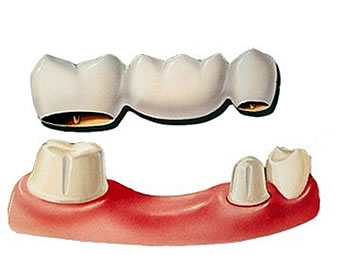 Why should I replace missing teeth?
Why should I replace missing teeth?
Your appearance is one reason. Another is that the gap left by a missing tooth can mean greater strain is put on the teeth at either side. A gap can also mean your "bite" is affected, because the teeth next to the space can lean into the gap and alter the way the upper and lower teeth bite together. This can then lead to food getting packed into the gap, which causes both decay and gum disease.
How are missing teeth replaced?
This depends on the number of teeth missing and on where they are in the mouth. The condition of the other teeth also affects the decision.
There are two main ways to replace the missing teeth. The first is with a removable false tooth or teeth - a partial denture. The second is with a fixed bridge. A bridge is usually used where there are fewer teeth to replace, or when the missing teeth are only on one side of the mouth.
What is a partial denture?
This is a plate with a number of false teeth on it. It may be all plastic or a mixture of metal and plastic. Both types may have clips (clasps), to help keep the denture in place in the mouth. Depending on where they are, some of these clips may show when you smile or open your mouth.
What is the difference between a plastic partial denture and one that contains metal?
A Plastic partial dentures are less expensive to make. But unless they are designed very carefully they can damage the teeth they fit against. Metal partial dentures are usually from an alloy of cobalt and chromium and they are much stronger. They are lighter to wear and can be supported by the remaining teeth. Although the base is metal, they have gum-coloured plastic and natural-looking teeth fixed to them. They are more expensive than the plastic ones.
How do I choose the best type for me?
Be guided by your dentist. He or she will know the condition of your remaining teeth and will be able to advise you on your individual situation. In most cases a metal-based partial denture gives the best result.
Can I have a bridge fitted straight after having a tooth removed?
In many people it can take up to 6 months for the gums to heal properly after an extraction. This means that you may need to have a temporary denture for 6 months before the bridge is fitted.
How do I look after my denture?
The general rule is: brush, soak, brush. Always clean your dentures over a bowl of water or a folded towel in case you drop them. Brush your dentures before soaking, to help remove any food debris. The use of an effervescent denture cleaner will help remove stubborn stains and leave your denture feeling fresher - always follow the manufacturer´s instructions - then brush the dentures again, as you would your own teeth, being careful not to scrub too hard as this may cause grooves in the surface. Most dentists advise using a small to medium headed toothbrush and toothpaste. Make sure you clean all the surfaces of the dentures, including the surface which comes into contact with your gums. This is especially important if you use any kind of denture fixative. If you notice a build up of stains or scale, have your denture cleaned by your dentist or hygienist.
Should I take my denture out at night?
Your dentist may recommend removing your dentures at night to give your mouth a chance to rest. If you remove your dentures, it is important to leave them in water to prevent any warping or cracking.
What is the alternative to a partial denture?
The main alternative is a fixed bridge. This is made by putting crowns on the teeth at either side of the space, and then joining these two crowns together by placing a false tooth in the space. This is all made in the laboratory and then cemented into place with special adhesives. The bridge cannot be removed for cleaning. Another option is an adhesive bridge. This has wings that are bonded to the back of the supporting teeth with very little drilling involved.
Can I always have a bridge to replace missing teeth?
Bridges are only possible if you have enough strong teeth with good bone support. Your dentist will help you decide which is the best way of replacing missing teeth.
What are bridges made of?
Bridges are usually made of porcelain bonded to precious metal. Sometimes, there are other non-precious metals used in the base for strength. There are also new bridges made entirely of a special type of strong porcelain.
What will a bridge cost?
Costs will vary according to the size and type of bridge you need. Always get a written estimate and treatment plan before beginning any dental treatment. Although a bridge may seem expensive it should last many years.
How do I look after my bridge?
You need to clean your bridge every day, to prevent problems such as bad breath and gum disease. You also have to clean under the false tooth every day. Your dentist or hygienist will show you how to use a bridge needle or special floss, as a normal toothbrush cannot reach.
Are there other methods for fixing false teeth?
There are other methods, such as using a combination of crowns and partial dentures that can keep the retaining clips out of sight. These are quite specialised dentures, so you should ask your dentist about them.
Can I have teeth which attach to the jawbone?
Yes, by having implants. The success of this technique means you may be able to replace missing teeth without crowning other teeth. See our leaflet "Tell me about Implants" for more details. Remember that it is as important to care for your remaining teeth as it is to replace the missing ones.
Crowns
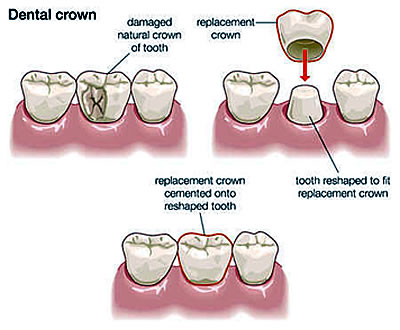 What is a crown?
What is a crown?
A crown is an artificial restoration that fits over the remaining part of a prepared tooth, making it strong and giving it the shape of a natural tooth. A crown is sometimes known as a "cap".
Why would I need a crown?
Crowns are an ideal restoration for teeth that have been broken, or have been weakened by decay or a very large filling. A crown could be used for a number of other reasons, for instance: you may have discoloured fillings and would like to improve the appearance of the tooth you may have had a root filling which may need a crown to protect what is left of the tooth it may help hold a bridge or denture firmly in place.
Crowns can improve the appearance of teeth.
What is a crown made of?
Crowns can be made of a variety of different materials and new materials are continually being introduced. Some of the most popular options are listed below. Porcelain bonded to precious metal: this is what most crowns are made from. A precious metal base is made and then porcelain is applied in layers over it. Porcelain crowns: these crowns are made entirely out of porcelain and are not as strong as bonded crowns, but they can look very natural and are most often used for front teeth. All-ceramic crowns: this modern technique offers a metal-free alternative, which can give the strength of a bonded crown and the appearance of a porcelain crown. Therefore it is suitable for use in all areas of the mouth. Glass: these crowns look very natural and are used on both front and back teeth. Gold alloy crowns: gold is one of the oldest filling materials. Today it is used with other metal alloys to increase its strength, which makes it a very hardwearing restoration. These crowns are silver or gold in colour.
How is a crown prepared?
The dentist will prepare the tooth to the ideal shape for the crown. This will involve removing most of the outer surface, and leaving a strong inner core. The amount of the tooth removed will be the same as the thickness of the crown. Once the tooth is shaped, the dentist will take an impression (mould) of the prepared tooth, one of the opposite jaw and possibly another to mark the way you bite together. The impressions will then be given to the dental technician, along with an appropriate shade and other information needed for the crown to be made.
What is a post crown?
In root-filled teeth it may be necessary to insert a post before placing a crown. A post provides support and helps the crown stay in place. The weakened crown of the tooth may be shortened to gum level. A post can be made of prefabricated stainless steel which the dentist can fit directly into the root canal, or a custom-made post can be constructed by the dental technician to accurately fit the shape of the prepared root canal. The post is placed into the root canal and cemented in position, ready for the crown to be attached.
Are there any alternatives to post crowns for root-filled teeth?
If a root-filled tooth is not completely broken down, it may be possible to build it up again using filling material. This "core" is then prepared in the same way as a natural tooth and the impressions are taken.
What will happen between visits?
A temporary crown will be made so that you can use the tooth while you wait for the crown to be made. This crown may be more noticeable but is only a temporary measure.
How is the crown fitted?
When you and your dentist are happy with the fit and appearance of the new crown it will be fixed in place with special dental cement or adhesive. The cement forms a seal to hold the crown in place.
How long does the treatment take?
You will need to have at least two visits: the first for the preparation, impression, shade taking and fitting the temporary crown; and the second to fit the permanent crown. There will usually be about 1 to 2 weeks in between appointments.
Does it hurt to have a tooth prepared for a crown?
No. A local anaesthetic is used and the preparation should feel no different from a filling. If the tooth does not have a nerve, and a post crown is being prepared, then a local anaesthetic may not be needed.
Will the crown be noticeable?
The crown will be made to match your other teeth as closely as possible. The shade of the neighbouring teeth will be recorded, to make sure that the colour looks natural and matches the surrounding teeth.
Will the crown feel different?
Because the shape of the crown will be slightly different from the shape of your tooth before it was crowned, you may be aware of it to begin with. Within a few days it should feel fine, and you will not notice it. The crown may need some adjustment if your bite does not feel comfortable and if this is the case you should ask your dentist to check and adjust it.
What will it cost?
Costs will vary according to the type of crown and material used. It is advisable to get a written estimate and treatment plan before beginning any dental treatment.
How do I care for my crown?
How long your crown lasts depends on how well you look after it. The crown itself cannot decay, but decay can start where the edge of the crown joins the tooth. Therefore, it is important to keep this area just as clean as you would your natural teeth in order to prevent decay affecting the crown.
How long will the crown last?
Properly cared for crowns should last for many years. Your dentist will be able to tell you how long the crown may be expected to last.
Cosmetic Dentistry
What is cosmetic dentistry?
Dentistry is no longer just a case of filling and extracting teeth, as it was for many years. Nowadays many people turn to cosmetic dentistry, or "aesthetic dentistry", as a way of improving their appearance, much as they would use cosmetic surgery or even a new hairstyle. The treatments can be used to straighten, lighten, reshape and repair teeth. Cosmetic treatments include veneers, crowns, bridges and tooth-coloured fillings.
What is a veneer?
Veneers are thin slices of porcelain. These are precisely made to fit over the visible surface of front teeth, like a false fingernail fits over a nail.
Why might I have a veneer?
Veneers are on ideal way of treating discoloured or unsightly teeth, closing gaps between front teeth, or repairing chips and cracks.
How are veneers made?
A small amount of enamel is removed from the tooth, usually the same thickness as the veneer will be. An impression is taken by the dentist and sent to a dental technician for the veneer to be made in the laboratory. The veneer is then bonded to the tooth to form a strong and natural-looking repair.
Can I have white fillings?
For over 150 years standard fillings have been made out of a silvery-grey material called "amalgam". This is considered one of the strongest and longest-lasting materials available for fillings. However, many people find it unattractive and some are concerned about possible health risks.
White fillings are now a popular alternative to amalgam fillings. The new dental materials mean it is much easier to find a perfect match for the shade of a particular tooth. In most cases, it is quite impossible to see that the tooth even has a filling. Sometimes white filling material can be used to cover unsightly marks on teeth, in a similar way to veneers.
How does the dentist make a crown?
The usual procedure for fitting a crown involves shaping the tooth under local anaesthetic and then taking an impression using a rubber-like material. The impression is then sent to the laboratory along with the details of the shade to be used, and the technician makes the crown.
What happens to my teeth while the crown is being made?
While your crown is being made, the prepared tooth can be protected with a temporary crown. This is easily removed just before fitting the permanent one. In most cases, the temporary crown is in place for approximately two weeks.
What is a crown made of?
Crowns can be made of a variety of different materials, such as porcelain or porcelain bonded to gold. New materials are continually being introduced. It is a good idea to talk to your dentist about which crown would be best for you.
How can my dentist fill a gap in my mouth?
If a tooth is missing, or needs extracting, there are several ways to fill the gap that is left. In some cases it is important to try to replace any missing teeth in order to balance the way your jaw bites. If you have several missing teeth, the remaining teeth are under more pressure, which can lead to broken fillings or even jaw problems.
A partial denture is the simplest way of replacing missing teeth. However, some people find dentures uncomfortable and eventually decide to look at alternatives.
What is a bridge?
Bridges are ideal for people who don´t like dentures or only have one or two teeth missing. Conventional bridges are made by crowning the teeth on either side of the gap and attaching a false tooth in the middle. They are fixed in the same way as crowns. These bridges are usually made of precious metal bonded to porcelain. Sometimes other non-precious metals are used in the base for strength.
What if I don´t want my remaining teeth drilled?
Adhesive bridges are another way of bridging a gap, and less of the tooth needs removing. These bridges are made up of a false tooth with metal "wings" on either side. These wings are made to bond to the teeth on either side, with very little drilling involved. Instead, the teeth are roughened and the bridge is fitted using a very strong composite resin.
Can implants be used to replace missing teeth?
"Implants" are an alternative to dentures or bridgework, but they are more expensive. Implants are titanium rods, which are surgically placed into the jawbone and act as anchors for fastening dentures or crowns onto.
Can I lighten the colour of my teeth?
Tooth whitening can be a highly effective way of lightening the natural colour of your teeth without removing any of the tooth surfaces. It cannot make a complete colour change, but it should lighten the existing shade.
What does tooth whitening involve?
Professional bleaching is the most common form of tooth whitening. Your dentist will apply the whitening product to your teeth, using a specially made tray which fits into your mouth like a gum-shield. The "active ingredient" in the product is usually hydrogen peroxide or carbamide peroxide. As the active ingredient is broken down, oxygen gets into the enamel on the teeth and the tooth colour is made lighter. Once your dentist has started this treatment you may be given the trays to take home and continue the treatment, or you may need further appointments at the dentist´s. This treatment can be done within 3 to 4 weeks, depending on how long you keep the trays in your mouth each time, and how much whiter you want your teeth to be.
What other procedures are there?
There is now laser whitening or "power whitening". During this treatment a light or laser is shone on the teeth to activate the chemical. The light speeds up the chemical reaction of the whitening product and the shade change can be achieved more quickly. Laser whitening can make teeth up to five or six shades lighter. This procedure usually takes about one hour.
What is an incorrect bite?
This is when the teeth do not fit in the jaw properly, when the teeth are not in the correct relationship with the rest of the face or if teeth are lost and not replaced.
What can happen if it is not treated?
If an incorrect bite is not treated the face can "collapse". This can cause the face to sag, the chin to stick out or the smile to droop. It can even cause headaches, neck pain and other pains in the body.
How can it be treated?
There are a number of treatments, including crowns, veneers and orthodontics (braces). Ask your dentist which treatment is most suitable for you. Ask for an estimate of the cost and a written treatment plan before you start.
Can my crooked or twisted teeth be straightened?
Teeth can be straightened with orthodontics (braces). This is usually done during the teenage years, when the teeth are going through a period of growth.
However, many adults also have treatment to straighten their crooked teeth or to improve their appearance. The procedure can take much longer in adults and is therefore more expensive. For cosmetic reasons, clear or plastic braces can be used, which are hardly noticeable. If you are considering orthodontic treatment, first go along to your dentist and get their advice. Your dentist can discuss your treatment options and if necessary refer you to an orthodontist.
Are there any alternatives to orthodontics?
Cosmetic contouring can be used to improve the appearance of teeth. It is ideal if you have irregular-shaped or slightly crowded teeth. However, in contouring the teeth a small amount of enamel would be lost. Contouring can also be used to improve the shape and appearance of your gums. These treatments are not recommended for young children.
What is tooth jewellery?
Tooth jewellery involves sticking small jewels onto the teeth using dental cement. They should be fitted by a dentist, who can easily remove them if necessary. It is important to keep the area around the jewel clean as plaque can easily build up around it and you will be more likely to get tooth decay.
White fillings
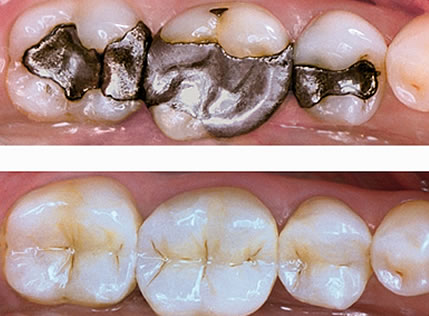 Why should I consider white fillings?
Why should I consider white fillings?
Most people have fillings of one sort or another in their mouths.
Nowadays fillings are not only functional, but can be natural looking as well. Many people don´t want silver fillings that show when they laugh or smile because they are more conscious about the way they look.
Are they expensive?
Because many white fillings are classed as a cosmetic treatment, you can only have them done privately. So costs can vary quite a lot from dentist to dentist. Costs usually depend on the size and type of white filling used and the time it takes to complete the treatment. Costs may also vary from region to region, but your dentist will be able to give you an idea of the cost before you agree to treatment.
Are they as good as silver amalgam fillings?
White fillings have always been considered less long lasting than silver amalgam fillings. But there are now new materials available with properties comparable to silver amalgam, and these are proving to be very successful. The life expectancy of a white filling can depend greatly on where it is in your mouth and how heavily your teeth come together when you bite. Your dentist can advise you on the life expectancy of your fillings. However, any fillings provided on the NHS are automatically guaranteed for one year.
Amalgam fillings in the teeth shown with the use of a rubber dam.
Is it worth replacing my amalgam fillings with white ones?
It is usually best to change fillings only when your dentist decides that an old filling needs replacing. If so you can ask to have it replaced in a tooth-coloured material.
Some dentists prefer not to put white fillings in back teeth as they are not always successful. One way around this would be to use crowns or inlays, but this can mean removing more of the tooth and can be more expensive.
What are tooth-coloured fillings made of?
This can vary, but they are mainly made of glass particles, synthetic resin and a setting ingredient. Your dentist should be able to give you more information about the particular material they use.
Where can I get them done?
Most dental practices offer white fillings as a normal part of the treatment they give you.
Are there any alternatives to fillings?
Adhesive dentistry is another form of this treatment. This involves bonding the filling to the tooth. The dentist has to remove less of the tooth, which is obviously better. As we have already said, there are alternatives such as crowns and inlays although they can cost a lot more. Veneers can be used on front teeth instead of crowns or fillings.
Veneers
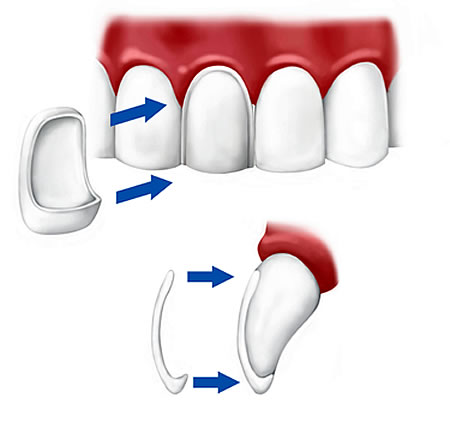 What is a veneer?
What is a veneer?
A veneer is a thin layer of porcelain made to fit over the front surface of a tooth, like a false fingernail fits over a nail. Sometimes a natural colour "composite" material is used instead of porcelain.
When would I need a veneer?
Veneers can improve the colour, shape and position of your teeth. A precise shade of porcelain can be chosen to give the right colour to improve a single discoloured or stained tooth or to lighten front teeth (usually the upper ones) generally. A veneer can make a chipped tooth look intact again. The porcelain covers the whole of the front of the tooth with a thicker section replacing the broken part. Veneers can also be used to close small gaps, when orthodontics (braces) are not suitable. If one tooth is slightly out of position, a veneer can sometimes be fitted to bring it into line with the others.
What are the advantages of veneers?
Veneers make teeth look natural and healthy. Because they are very thin and are held in place by a special strong bond (rather like super-glue) very little preparation of the tooth is needed.
How are teeth prepared for a veneer?
Some of the shiny outer enamel surface of the tooth may be removed, to make sure that the veneer can be bonded permanently in place later. The amount of enamel removed is tiny and will be the same as the thickness of the veneer to be fitted, so that the tooth stays the same size. A local anaesthetic (injection) may be used to make sure that there is no discomfort, but often this is not necessary. Once the tooth has been prepared, the dentist will take an "impression" (mould). This will be given to the dental technician, along with any other information needed to make the veneer. The colour of the surrounding teeth is matched on a shade guide to make sure that the veneer will look entirely natural.
How long will it take?
A veneer takes at least two visits: the first to prepare the tooth and to match the shade, and the second to fit it. Before bonding it in place, your dentist will show you the veneer on your tooth to make sure you are happy with it. Bonding a veneer in place is done with a special adhesive, which holds it firmly on the tooth.
Will I need a temporary veneer between visits?
Because the preparation of the tooth is so slight you will probably not need a temporary veneer. The tooth will look very much the same after preparation, but will feel slightly less smooth.
What happens after the veneer is fitted?
Only minor adjustments can be made to the veneer after it is fitted. It is usually best to wait a little while to get used to it before any changes are made. Your dentist will probably want to check and polish it a week or so after it is fitted, and make sure that you are happy with it.
How much will it cost?
The costs for this treatment can vary from practice to practice so it is important to discuss charges and treatment options with your dentist before starting treatment.
How long will veneers last?
Veneers should last for many years; but they can chip or break, just as your own teeth can. Your dentist will tell you how long each individual veneer should last. Small chips can be repaired, or a new veneer fitted if necessary.
What about alternatives?
A natural-coloured filling material can be used for minor repairs to front teeth. This is excellent where the tooth supports a filling, but may not work so well for broken tooth corners. There will always be a join between the tooth and the filling material. Crowns are used for teeth which need to be strengthened - either because they have broken, have been weakened by a very large filling, or have had root canal treatment.
Implants
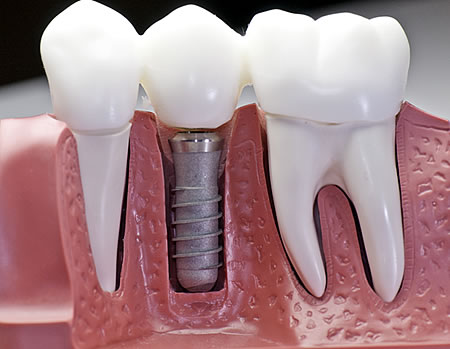 What are dental implants?
What are dental implants?
A dental implant is a titanium metal rod which is placed into the jawbone. It is used to support one or more false teeth. In practice, both the false teeth and their supporting rod are known as "implants".
Are implants safe and how long will they last?
Implants are a well-established, tried-and-tested treatment. Over 95% of modern implants should last for many years with the right care.
I have some of my own teeth. Can I still have implants?
Yes. You can have any number of teeth replaced with implants - from one single tooth to a complete set.
Can implants always be used to replace missing teeth?
It depends on the condition of the bone in your jaw. Your dentist will arrange for a number of special tests to find out the amount of bone still there. If there is not enough, or if it isn´t healthy enough, it may not be possible to place implants without grafting bone into the area first.
Do implants hurt?
Placing the implants means a small operation. This can be done using a simple local anaesthetic, and sometimes with sedation if you are very nervous. Sometimes the dentist needs to use a general anaesthetic for complex cases. You will not feel any pain at the time, but you may feel some discomfort during the week after the surgery. This is usually due to having stitches, and the normal healing process.
How long does treatment take?
Your dentist will be able to give you a rough timetable A before the treatment stark. Usually the permanent teeth are fitted 6 to 9 months after the implants are put in, but many implant systems now allow the time to be as short as 3 months. Some teeth can now even be fitted at the same time as the implants (known as immediate implants) but you should check with your dentist to see whether these are suitable for you.
What about after care?
Your dentist may give you some pain relief after the surgery, or check whether you have them at home to take over the next few days if you need them. Your dentist may also prescribe antibiotics. Don´t smoke, exercise or drive for the rest of the day. Don´t rinse the area and only eat soft foods. However, it is important that you keep your mouth clean by brushing - but do not poke the implant site. You can use a chlorhexidine mouthwash every day during the first week after surgery (you can get these from supermarkets and chemists).
What happens next?
The implants need to bond with the bone after they have been put in. This usually takes at least 3 months in the lower jaw and 6 months in the upper jaw. Sometimes the implants may be stable enough when they are fitted for the artificial teeth to be attached much sooner than this.
If you are having one, two or three teeth replaced, you may have a temporary denture in the meantime. If you have complete dentures, then you can keep wearing these throughout the healing period once they have been modified after the surgery. A healing cap will usually be placed onto the implant site to protect the area during healing.
Are the teeth difficult to clean?
No. But after care is important if you are going to have a long-lasting, successful implant. Your dentist should give you detailed advice on how to look after your implants. Cleaning around the teeth attached to the implants is no more difficult than cleaning natural teeth. However, there may be areas that are difficult to reach and you´ll be shown methods to help you. You may need to visit your hygienist more often but your dentist will be able to talk to you about this.
If I had gum disease when I had my own teeth, will I get it with the teeth attached to the implants?
Yes, if you don´t care for them well enough. If you keep them clean, and don´t smoke, then you should not have any problems.
Can I take the teeth out if they are fixed to implants?
Most artificial teeth attached to implants can only be placed and removed by the dentist. However, if you have complete dentures fixed to the implants by bars, then you´ll be able to take them out for cleaning.
Do the implants show?
Your dentist will make sure that the implants won´t show during all normal movements of the mouth and lips. You will need to be able to see them, so that you can clean them properly.
Do I have an implant for each missing tooth?
No, unless you´re only having a single tooth replaced. Normally, five or six implants are used to replace all the teeth in one jaw, as each implant can usually support two teeth. For a few missing teeth, two or three implants may be used.
What if I have an accident?
Implants and the teeth they support can be damaged by an accident in the same way that natural teeth can. It is therefore important that you wear a professionally made mouthguard if you play sports that involve contact or moving objects. If there is damage, the teeth can be dismantled from the implant and replaced. However, if the titanium rod is damaged beyond repair, this part may be safely left in the jaw if it is too difficult to remove. Another implant may be placed alongside it to replace the damaged implant.
What happens if the implant does not bond with the bone?
This happens very rarely. If the implant becomes loose during the healing period or just after, then it is easily removed and healing takes place in the normal way. Once the jaw has healed, another implant can be placed there. Or, the dentist can make a bridge, using the implanted false teeth that have "taken".
Is the treatment expensive?
Unfortunately, yes. However, in many situations, the cost of the treatment is only a little more than the cost of more conventional treatment with crowns and bridges. Over the longer term, implants are usually a more cost-effective and satisfactory option. There are advantages to it, too. An implant to replace a single tooth avoids the need to cut down the teeth either side for crowns to support a bridge. Normal dentures often mean you can´t eat or speak well, due to the dentures moving about. But teeth attached to an implant don´t cause this problem as they are anchored to the bone more firmly than natural teeth.



